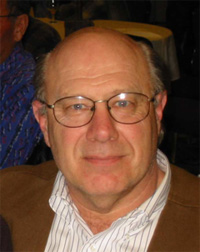Art Form: Barn preservation and timber frame building arts
Location(s): Empire (Leelanau County)
Stephen Stier

Portrait of Stephen Stier
Stephen “Steve” Stier (b. 1946) is a native of Illinois who moved to Michigan in his youth and has since spent the majority of his life devoted to the building arts in the state. He holds a degree in industrial arts education from Western Michigan University and masters degree in historic preservation from Eastern Michigan University (EMU). Steve is a licensed builder who focuses on historic preservation skills and practices. He is experienced in wooden boat rehabilitation and is a barn wright. In his nomination letter for Steve, Ted Ligibel, Ph.D., director of EMU's historic preservation Program, states, “Steve’s knowledge of the built environment and traditional construction techniques is nothing short of amazing and his carpentry, masonry, and restoration skills are superior.”
He has worked in and with museums in Maine and Michigan, including Michigan State University Museum where he was appointed as a research associate for traditional building craft. It is for his work, however, as a tireless preservation advocate and educator, especially in the realm of timber-framing and barn preservation, that he is being honored with the Michigan Heritage Award. Steve's contributions to the community of barn workers, preservationists, educators, and historians are unparalleled.
A longtime member of the Michigan Historic Preservation Network, Steve established the historic trades program at Randolph Career and Technical Center (Detroit) and developed the network's window rehabilitation training series. As adjunct faculty with EMU's Historic Preservation Program, Steve has been an instructor for over dozen field schools for hands-on preservation. He has also served as the preservation instructor on the restoration of the historic Goffar Barn in the Port Oneida Rural Historic District, Sleeping Bear Dunes National Lakeshore in Leelanau County.
Steve co-developed the Michigan Barn and Farmstead Survey that has engaged hundreds of individuals, including many 4-H youth, throughout the state in documenting this important and often endangered aspect of Michigan’s built landscape. To support this activity, in 2000 he and Vera Wiltse co-authored the Michigan Barn and Farmstead Survey Manual published by the MSU Museum. Steve was a founding board member and president of the Michigan Barn Preservation Network.
Richard Roosenberg, executive director of Tillers International, a Michigan organization that Steve has assisted in educational programs and in building perhaps as many as 20 barns, states: “Steve has always known that preservation of barns and timber framing was not just the structure of the moment, but drawing in people, educating them in the uniqueness of these structures, describing the roles the buildings played in our culture, and etching the muscles needed to keep them standing tall.”
Steve intimately understands the need to honor and perpetuate traditional building skills to achieve both excellence and authenticity in his construction and preservation work. As another nominator put it, “Steve, when given the opportunity to use newer high tech tools and methods to repair a barn, often opted for a more traditional way to solve a problem with excellent outcome.”
- Marsha MacDowell, 2015





